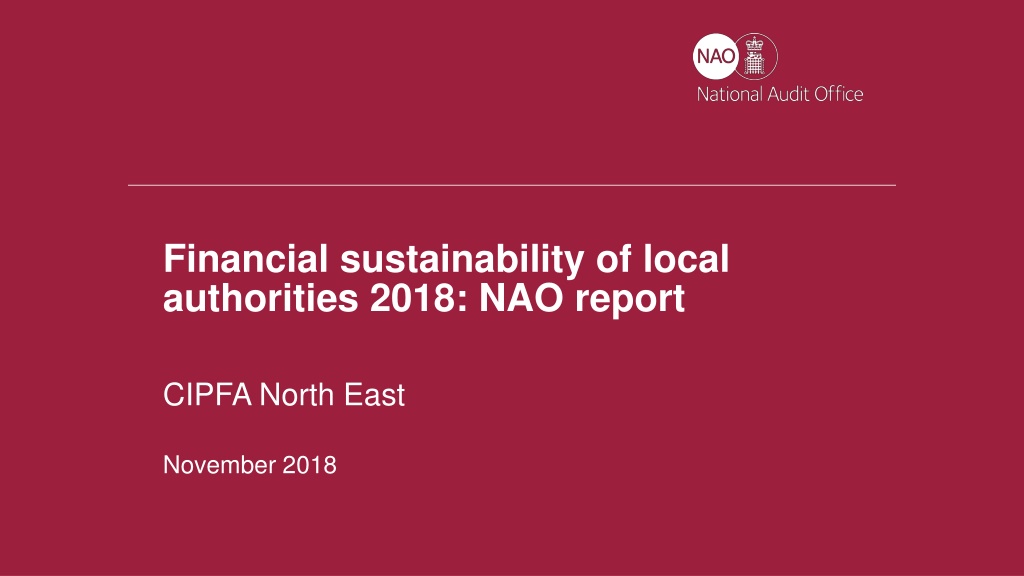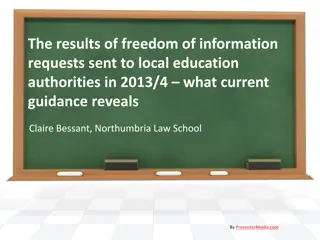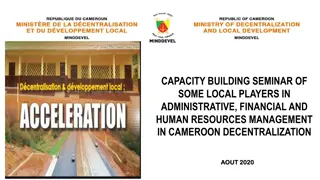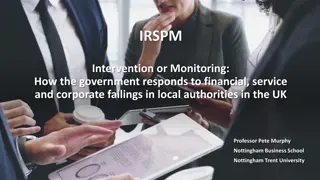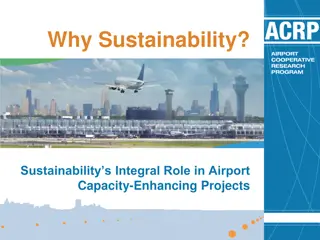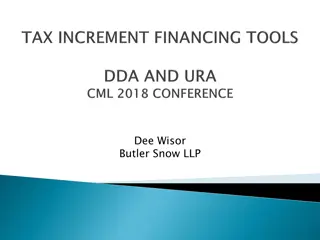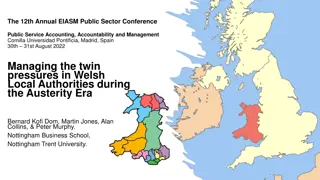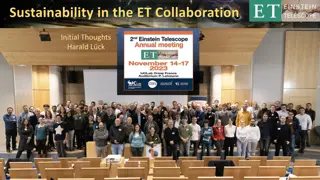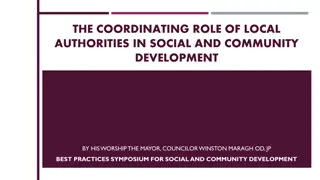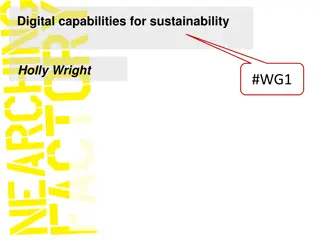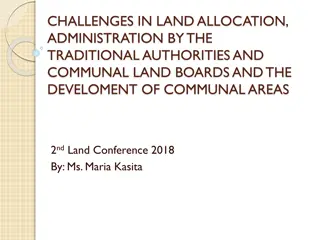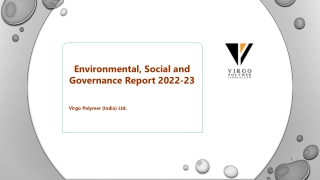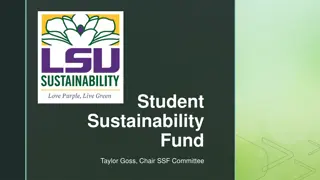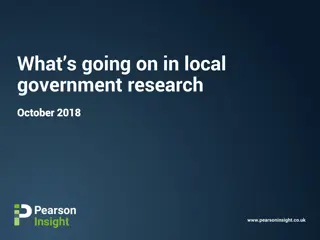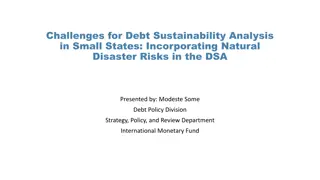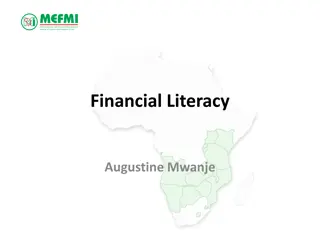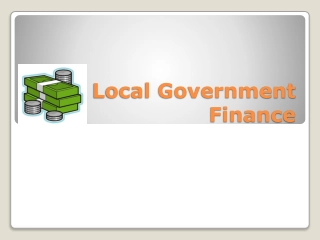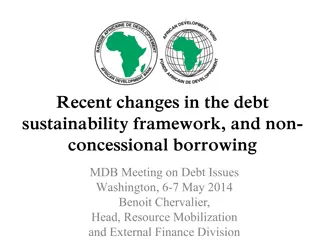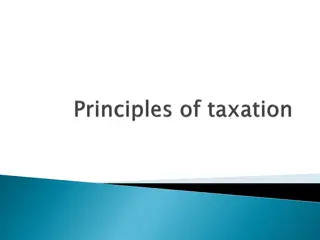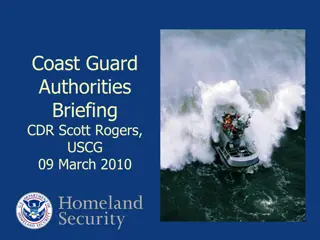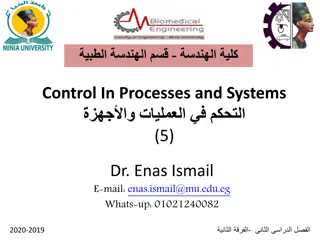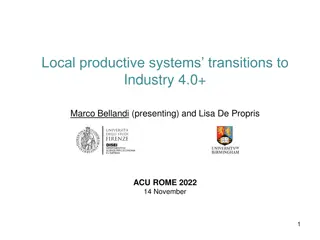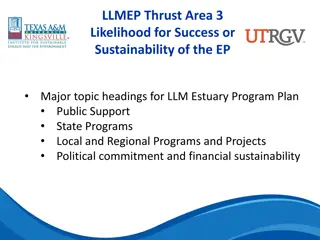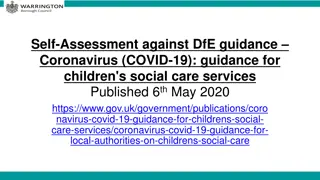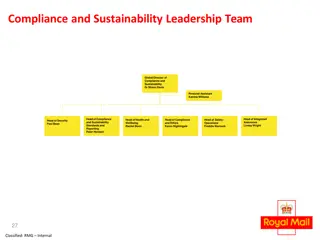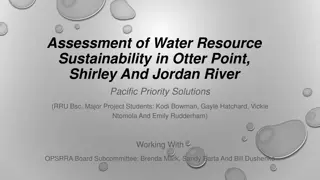Financial Sustainability Challenges and Responses in Local Authorities
The report analyzes the financial sustainability of local authorities since 2010-11, highlighting funding reductions, variation in spending power, and growing demand for services. It examines how councils have responded to challenges and questions the government's understanding of funding requirements and accountability in managing risks to financial and service sustainability.
- Financial Sustainability
- Local Authorities
- Funding Reductions
- Service Demand
- Government Accountability
Download Presentation

Please find below an Image/Link to download the presentation.
The content on the website is provided AS IS for your information and personal use only. It may not be sold, licensed, or shared on other websites without obtaining consent from the author. Download presentation by click this link. If you encounter any issues during the download, it is possible that the publisher has removed the file from their server.
E N D
Presentation Transcript
Financial sustainability of local authorities 2018: NAO report CIPFA North East November 2018 LSDUE staff survey analysis
Overview | Our report Three questions: What financial and demand challenges have councils faced since 2010-11 and how have they responded? What have been the implications of funding reductions for service and financialsustainability in the sector? Does the Department have a clear understanding of councils funding requirements, and does it understand the effectiveness of its accountability system for managing risks to financial and service sustainability? LSDUE staff survey analysis
Challenges | Funding reductions since 2010-11 120 Substantial real terms falls in government funding: 49.1% reduction 2010-11 to 2017-18 56.3% reduction by 2019-20 Spending power (real terms in 2016-17 prices) (indexed: 2010-11=100 100 80 Spending power fell steadily from 2010-11 to 2016-17 (28.5%) then levelled off: relies on substantial anticipated growth in council tax. 60 40 20 Much new cash is also focused solely on ASC. Non ASC funding falls by 8.2% from 2016-17 to 2019- 20 0 2010-11 2011-12 2012-13 2013-14 2014-15 2015-16 2016-17 2017-18 2018-19 2019-20 Spending power Government funded spending power Council tax LSDUE staff survey analysis
Challenges | Variation in funding reductions 0.0 2010-11 to 2017-18 (%) (real terms in Median change in spending power -5.0 -10.0 Significant variation in spending power reductions between and within different types of LA -15.0 2016-17 prices) -22.1 -20.0 -25.0 -27.9 -30.1 -30.0 -32.2 -33.9 -35.0 -40.0 -45.0 -50.0 Metropolitan District Councils London Borough Councils Unitary Authorities County Councils Shire Districts LSDUE staff survey analysis
Challenges | Growing demand on local authorities 135 10.9% increase in children looked after 2010-11 to 2016-17 Change in indicator (%) (indexed:2010-11=100) 130 125 9.5% increase in the estimated population in need aged 18-64 120 115 14.3% increase in the population in need aged 65 and over 110 105 100 33.9% increase in households accepted as unintentionally homeless and in priority need 2010-11 2011-12 2012-13 2013-14 2014-15 2015-16 2016-17 Number of children looked after Est. pop. in need aged 65 and over Est. pop. in need aged 18 to 64 H'holds unintentionally homeless & priority need LSDUE staff survey analysis
Responses | How LAs offset funding reductions has changed First three years reductions in service spend were greater than reductions in main income streams. Allowed LAs to grow reserves and increase other spending. 2010-11 to 2011-12 2011-12 to 2012-13 2012-13 to 2013-14 2013-14 to 2014-15 2014-15 to 2015-16 2015-16 to 2016-17 Year-on-year change ( billion) (real terms in 2016-17 1.bn .5bn .bn - .5bn - 1.bn prices) Marked switch in second three year phase: Service reductions account for less than half of funding reductions. Use of reserves and reductions in other spend become more important. - 1.5bn - 2.bn - 2.5bn - 3.bn - 3.5bn - 4.bn Also growth in alternative income (shown in negative in the chart). Change in service spend Change in other spending Change in appropriations to/from reserves Change in alternative income LSDUE staff survey analysis
Responses | Reducing other spend & increasing income Since 2013-14 LAs have reduced spend on debt servicing by 680m and CERA by 240m 4.bn Spend/income ( billion) (real terms in 2016-17 3.5bn 3.bn 2.5bn LAs increased income from trading profits and external interest by 200m prices) 2.bn 1.5bn Overall this allowed LAs to reduce service spending reductions and/or use of reserves by 1.12bn. 1.bn .5bn .bn Debt Servicing Capital spend funded from revenue (CERA) Trading profit Interest payments Spend Income 2010-11 2011-12 2012-13 2013-14 2014-15 2015-16 2016-17 LSDUE staff survey analysis
Service sustainability | Reductions in service spend 250m 10% Social care spend has been relatively protected: 3.3% reduction ASC (including BCF) 3.2% growth in CSC. Change in spend (%) (real terms at 2016-17 prices) Change in spend ( m) (real terms at 2016-17 prices) m 0% - 250m -10% Other services have been cut substantially: 52.8% cut in planning and development 45.6% cut in housing services (non-HRA) 37.1% cut in highways and transport services 34.9% cut in cultural and related services 16.9% cut in environmental and regulatory services 14.6% in central services - 500m -20% - 750m -30% - 1000m -40% - 1250m -50% m % - 1500m -60% Planning and development services Housing services (GFRA only) Highways and transport services Cultural and related services Environmental and regulatory services Central services Adult Social Care Children's Social Care LSDUE staff survey analysis
Service sustainability | Trends in service spend Social care spend fell from 2010-11 to 2014-15 but has started to grow since then. 25bn Service spend ( billions) (real terms in 2016- 20bn Non-schools education: our analysis shows it made a significant contribution to savings in the early years but has since levelled off. 15bn 17 prices) 10bn Sharp fall in spend on other services in first year then steady falls in each year. Implies that the switch away from savings reductions in the second three year period of austerity does not apply to these services. 5bn bn 2010-11 2011-12 2012-13 2013-14 2014-15 2015-16 2016-17 Social Care Non-schools Education Other services LSDUE staff survey analysis
Service sustainability | Overall spending reductions 10.0% Marked reductions in overall service spend 0.0% 19.2% reduction in overall service spend made up of 3% reduction in social care spend (excl BCF), and a 32.6% reduction in other spending. Change in Spend (real terms 2016-17 prices) Change in overall service spend 2010- 11 to 2016-17 (%) -10.0% Change in spend on non-social care services 2010-11 to 2016-17 (%) -20.0% Marked differences in spending cuts between LA types. Change in spend on social care 2010-11 to 2016-17 (%) -30.0% -40.0% Metropolitan districts London boroughs Unitary authorities Two tier areas All LSDUE staff survey analysis
Service sustainability | Concentration on social care 58% Social care as a share of service spend Across the sector as a whole social care has grown from 45.3% to 54.4% of service spend 56% 54% 52% 50% (%) (NCE) 48% 46% Marked differences in the share of spend accounted for by social care across different LA types/areas. 44% 42% 40% 2010-11 2011-12 2012-13 2013-14 2014-15 2015-16 2016-17 Metropolitan districts London boroughs Unitary authorities Two tier areas LSDUE staff survey analysis
Service sustainability | Total spend has not fallen as much as net spend Total spend (which includes net spend) also includes spend funded by sales fees, and charges and other income such as transfers from other bodies. 10.0% Change in spend 2010-11 to 2015-16 (%)(real terms in 2016-17 prices) 0.0% -10.0% In many services total spend has not fallen as sharply a net spend often because income from sales, fees and charges has grown. -20.0% -30.0% This means that a greater share of the cost of service provision falls on the user. More limited falls in total spend may partially explain why the public response to service spending reductions has perhaps not been as marked as expected. -40.0% -50.0% -60.0% Planning and development services Housing Services (GFRA Only) Highways and transport services Cultural and related services Environmental and regulatory services Central services Adult Social Care Children's Social Care Change in Net Current Spend Change In Total Spend LSDUE staff survey analysis
Service sustainability | Growing overspends 1200m The sector as a whole had a service overspend of 901m in 2016-17 1000m Net variance between budget and outturn 800m Single tier and county councils have switched from a period of service underspends to growing overspends - 1bn in 2016- 17. 600m ( million) (cash terms) 400m 200m m - 200m District councils as a whole have managed to deliver underspends. - 400m - 600m - 800m 2011-12 2012-13 2013-14 2014-15 2015-16 2016-17 Single tier and county councils District councils All local authorities LSDUE staff survey analysis
Financial sustainability | Variance by service area Overspends in STCCs driven by growing overspends in CSC and ASC. 1200m Net variance between budget and outturn spend 1000m 800m ( million) (cash terms) 600m 400m Some evidence that underspends in other service areas have started to fall contributes to growth in aggregate overspends. 200m m - 200m - 400m - 600m - 800m Children's Social Care Adult Social Care Other All Services 2011-12 2012-13 2013-14 2014-15 2015-16 2016-17 LSDUE staff survey analysis
Financial sustainability | Levels of reserves 100% Reserves (shown as a share of net revenue expenditure in the chart) are higher in 2016-17 compared to 2010-11 particularly for district councils. Reserves as percentage of net revenue 90% 80% expenditure (cash terms) 70% 60% 50% 40% 30% STCCs as a whole have grown their reserves but both earmarked and unallocated reserves started to fall in 2016- 17. 20% 10% 0% 2010-11 2011-12 2012-13 2013-14 2014-15 2015-16 2016-17 Single tier and counties (earmarked) Districts (earmarked) Single tier and counties (other) Districts (other) LSDUE staff survey analysis
Financial sustainability | Use of reserves (STCCs) High point for growth in reserves for STCCs was 2012-13 trend started to change at that point. 2000m 80% Change in reserves in year ( m) (cash terms) Number of local authorities drawing on reserves (%) 1500m 60% 1000m 40% In 2016-17 66.2% of STCCs drew on their total reserves - 858m. 500m 20% m 0% 2010-11 2011-12 2012-13 2013-14 2014-15 2015-16 2016-17 - 500m -20% Latest figures show an upturn - 1000m -40% Change in total reserves ( m) Number of local authorities drawing on reserves (%) LSDUE staff survey analysis
Financial sustainability | Unplanned use of reserves However, a substantial amount of gross use of reserves is on an unplanned basis an LA has not budgeted to use these reserves, or did budget to use less than planned. 1500m Movement in reserves ( million) (cash) 1000m 500m m This may indicate that LAs are struggling to implement savings plans or manage costs in-year, though there are of possible explanations for unplanned use of reserves. - 500m - 1000m 2011-12 2012-13 2013-14 2014-15 2015-16 2016-17 Growth, where unplanned Use, where planned Growth, where planned Net change Use, where unplanned LSDUE staff survey analysis
Financial sustainability | Overspends & use of reserves Growing social care overspends linked with an increase in use of reserves by STCCs 100% 9.9% 10.6% 90% 19.7% 9.3% 11.8% 34.9% 80% Number of single tier and county councils (%) 44.1% 47.4% 8.6% 70% 23.2% But difficult to prove precisely that LAs are funding their social care overspends by drawing on their reserves. 7.2% 60% 40.8% 7.2% 50% 6.6% 46.1% 40% 40.8% 30.9% 30% 37.5% 57.0% 20% 37.5% 25.7% 10% 17.1% 15.1% 11.2% 0% 2011-12 2012-13 2013-14 2014-15 2015-16 2016-17 No social care overspend - did not use reserves No social care overspend - used reserves Social care overspend - did not use reserves Social care overspend - used reserves LSDUE staff survey analysis
Financial sustainability | Dwindling reserves Many STCCs have built up their reserves. Use of reserves in itself does not indicate financial vulnerability. 25% 20% Single tier and county councils (%) However not all STCCs were able to build up their reserves, and some of them are consuming them very rapidly. 9.9% 15% 10% Based on their rate of use in that year 10.6% of STCCs had the equivalent of less than three years worth of reserves left. 3.3% 7.9% 10.6% 5% 3.3% 2.0% 2.6% 4.0% 2.6% 2.0% 2.0% Compared to previous years there has been a marked growth in the number of STCCs that are drawing down their reserves rapidly relative to their scale 0.7% 1.3% 2014-15 0.7% 0% 2010-11 2011-12 2012-13 2013-14 2015-16 2016-17 Up to 3 years 4 to 5 years LSDUE staff survey analysis
Financial sustainability | Limited room for manoeuvre A lack of reserves or their rapid use is a potential concern. 70% 65% Social care as a share of service spend (%) (net current 60% So is a concentration of service spend on social care as this means LAs have less room for making further savings in service spend. 55% 50% spend) 45% 40% In 2016-17 10% of STCCs spent over 65% over their service spend on social care (and this includes non-schools education). 35% 30% 25% 2010-11 2011-12 2012-13 2013-14 2014-15 2015-16 2016-17 LSDUE staff survey analysis
Overview | VfM conclusion MHCLG The sector has done well to manage substantial funding reductions since 2010-11, but financial pressure has increased markedly since our last study. The current pattern of growing overspends on services and dwindling reserves exhibited by an increasing number of authorities is not sustainable over the medium term. The financial uncertainty created by delayed reform to the local government financial system risks longer-term value for money. The Department s performance has improved since our last study however, conditions in the sector have worsened and the Department must continue to strengthen its oversight and assurance mechanisms. LSDUE staff survey analysis
Overview | VfM conclusion wider government The Department s capacity to secure the sector s financial sustainability in the context of limited resources is shaped by the priorities and agendas of other departments. Each department has its own narrow view of performance within its own service responsibilities. There is no single central understanding of service delivery as a whole or of the interactions between service areas. To date, the current spending review period has been characterised by one-off and short-term funding fixes. Where these fixes come with restrictions and conditions, this poses a risk of slowly centralising decision-making. This increasingly crisis-driven approach to managing local authority finances also risks value for money. The current trajectory for local government is towards a narrow core offer increasingly centred on social care. This is the default outcome of sustained increases in demand for social care and of tightening resources. The implications for value for money to government from the resulting re-shaping of local government need to be considered alongside purely departmental interests. LSDUE staff survey analysis
Overview | Recommendations The Department should work with the sector to develop a long-term plan that is genuinely able to address the current financial and demand pressures in the sector and to secure its financial sustainability. The Department should continue to strengthen its processes for assessing local authority funding requirements at future spending reviews especially in children s social care. The Department should continue to build on its improved oversight of the sector s financial sustainability. The government, led by the Department, should develop a clear understanding of the role and significance of local authorities as a whole in the context of the current funding climate. The government should improve outcome data. LSDUE staff survey analysis
Overview | PAC report recommendations Financial failure MHCLG should report to the Committee on what it is doing to minimise the risk of financial failure work with local authorities and key stakeholder bodies to agree a shared definition of local authority financial sustainability and a methodology for assessing the extent to which local authorities are at risk. Spending Review make a persuasive case to HM Treasury for local authority funding at the next Spending Review and be more transparent and publish projections of demand and outcomes work with other departments to ensure that it properly understands local authorities performance across the full range of local services Changes to the LG finance system publish a timetable showing when it will have to take key decisions on the Fair Funding Review, 75% local retention of business rates and the 2019 Spending Review. provide assurance to local authorities on funding for 2020-21 and 2021-22 and on transition LSDUE staff survey analysis
Thank you Subscribe to notifications with NAO preference centre All reports are available at www.nao.org.uk Follow the NAO on Twitter @NAOorguk Please contact Mike Newbury with any further questions Mike.newbury@ nao.org.uk View our blog www.nao.org.uk/ naoblog Explore your authority at our interactive data www.nao.org.uk/highlights/fi nancial-sustainability-of- local-authorities-2018- visualisation LSDUE staff survey analysis
